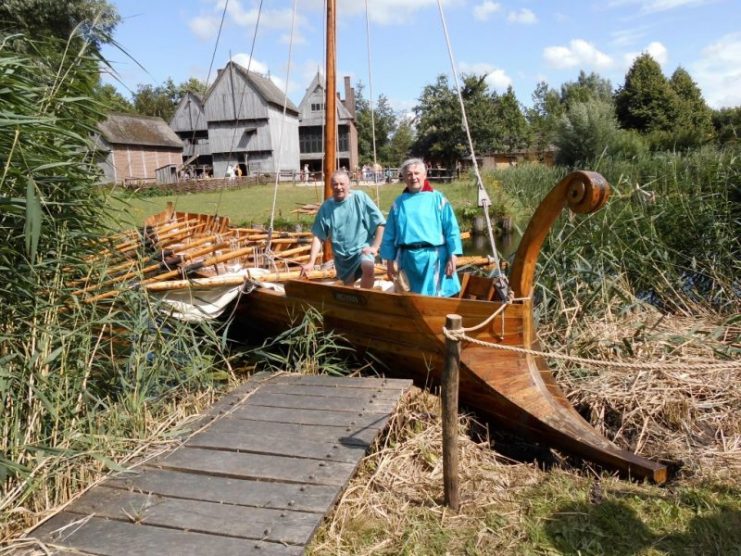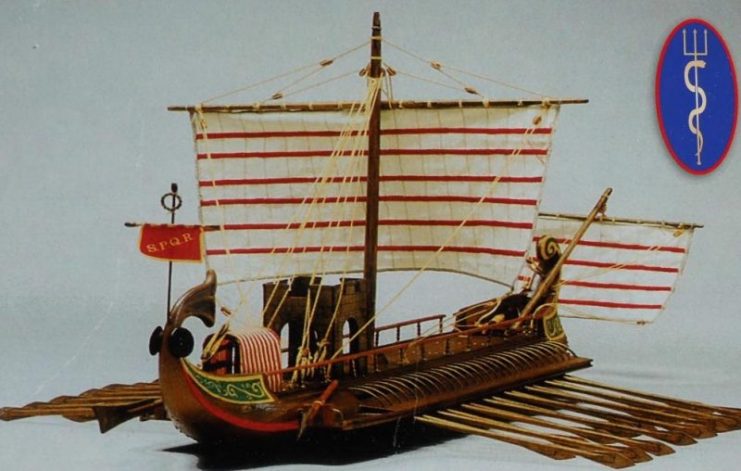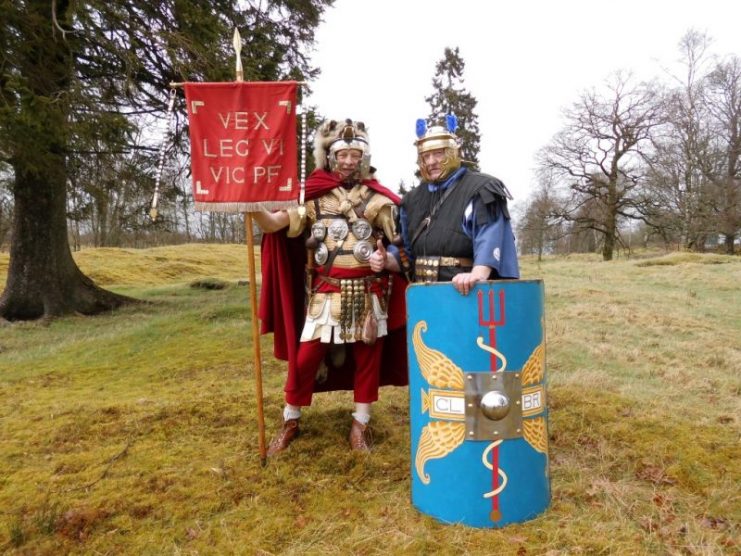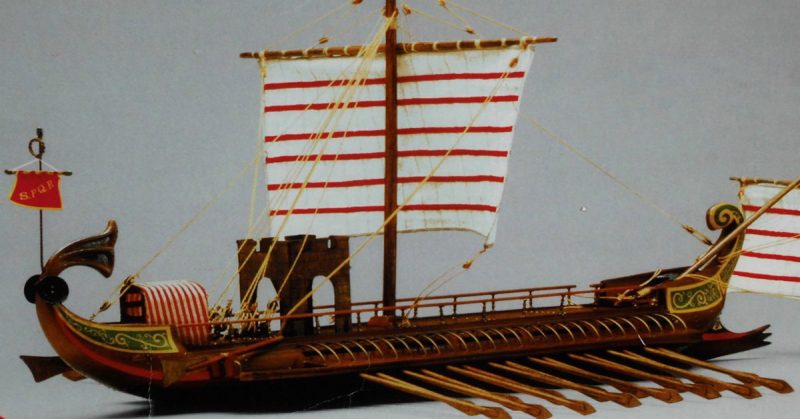War History online proudly presents this Guest Piece from John S. Richardson
The Roman Empire is best known for its Army Legions who ruled the then known world and were famous for their ability to succeed even after their greatest defeats. However, while the Legions of Rome were the all-conquering land forces, it must be remembered that by the time of Julius Caesar the Romans had also built up a formidable Navy which controlled the Mediterranean.
After the invasion of Britain Emperor Claudius set in motion in AD 43 what was to become Britain’s first great naval power, the Classis Britannica. It became a vital trading vehicle for Imperial Rome but also a very efficient fighting force in its own right. Its history can be traced right back to around the middle of the third century AD.
It consisted of different types of naval vessels with their own manpower and tactics for war at sea which was all made possible by the best of Roman technology. The Classis Britannica with its counterpart the Classis Germanica played an essential role in the Roman campaigns in Europe under various Emperors. They not only operated in the seas around Britain but also in the North Sea carrying men and supplies across the Roman Empire.
The Imperial Roman Navy had within its structures many large galleys which were developed from ships made by the Greeks and Phoenicians. It was from those seafaring peoples that the ancient Romans gained the knowledge and skills required for them to become the dominant naval power in the Mediterranean.
Unlike as depicted in Hollywood movies, Roman sailors were free men and were skilled and experienced in how to handle large vessels at sea.
The warships used by the Roman Navy were mainly constructed to carry large numbers of men who were trained to fight not only on land but also at sea. They were an early form of marines. They knew how to board enemy ships and successfully defeat them.
By the time of the invasion of Britain by Emperor Claudius, the Romans realized their large ships were incurring substantial losses of their skilled sailors and marines. The Roman Senate reorganized the Imperial Fleets and subsequently ordered the design and building of smaller faster ships. It broadened out the areas the fleets covered and gave added protection to the many merchant ships trading with Britain and the continent of Europe.
Other countries adopted the change as the Roman way showed positive results in gathering intelligence reports. Using their navy, important messages were speedily circulated to Governors and military commanders of the many regions within the Roman Empire.
Roman Naval Organization
The commander or captain of a ship was known as the Trierarch. Their terms of service were similar to those of their land-based counterparts in the Legions. The crew, consisting of both sailors and marines, served up to 25 years. They were fully trained professionals who volunteered their service to crew the ships of the Classis Britannica and other fleets.

In the broad range of vessels within those fleets, the main source of power was a combination of wind and oars. Depending on the type of ship and its size the rowers were arranged in either a single bank or on decks, so their oars were one above the other. In battle, the sails were taken down, which lessened the risk of fire to the ships.
These ancient Roman vessels had no rudder as ships of today have. They were steered by two sailors holding large wooden oars placed upon the ship’s stern. Crew sizes varied, but it is estimated that for a vessel with 300 men on board, 250 of them would be manning the ship while the rest were the main fighting force of marines. One crucial aspect of having such a significant amount of manpower was to allow a vessel to travel at the speed the captain needed.
The front of a Roman Naval warship had a large bronze ram’s head mounted upon it. It was fitted just below the waterline and was driven into the side of an enemy vessel to sink or immobilize it.
The Raven
As Roman ships approached an enemy ship, they used what was known as the Raven. It was made from large planks of wood with an enormous spike on one end which when dropped by the Roman sailors penetrated the enemy ship’s decks and held the two vessels firmly together. The marines then boarded and engaged their enemy.

As well as having marines on board its biggest ships the Roman Navy also had their own artillery/catapults mounted on the upper decks. They had a firing range of around 600 meters and sitting high out of the water those vessels provided excellent protection for their crew. For the archers, there were mounted wooden towers which gave them elevated firepower.
Classis Britannica
Ancient Imperial Rome was one of the most successful empires in history. They realized that if their Legions were to be successful, then their Navy had to rule the seas. Without doing so, their empire may not have flourished as it did. Having control not only meant better communication across the Empire but also greater safety for the maritime traders and their ships.
The Roman Governor of Britain Julius Agricola, sent his warships to sail around the coastline of Britain. He used the Fleet in his drive to conquer the Island of Britain and its warring tribes in the north.
Britain’s first great navy began during the period of the Flavian Rulers in Rome. When Claudius gave the invasion signal to take the Legions across the English Channel, it was the birth of the Classis Britannica.
In ancient Gaul, present-day France, Boulogne became the headquarters of the British Fleet. It helped to make those in power in Rome feel more secure by preventing any Governors or admirals seeking power, as had been the case earlier when Dover was used as a base.
There are no records from that time of any serious threat by opposing naval powers in the seas around the British Coast. The standard types of vessels used by the Classis Britannica were the Liburna and the Bireme although there were also two larger Triremes in the British Fleet based at Boulogne.
Both the Liburna and the Bireme were more suited to British waters and inland rivers and ideal for speed when required.
Like navies around the world today, the ancient Romans were also keen to give their ships names, such as Neptune.
The Classis Britannica carried out many operations with its sister fleet the Classis Germanica. The British Fleet patrolled not only the British coastline but also the Irish Sea, the English Channel, and the North Sea. Its crews were very experienced sailors having been recruited from seafaring countries all across the empire. It not only complemented the fleet’s use of technology but also raised the skills required when dealing with different conditions faced by the crews.
From the period of Agricola in AD 77 up until the time of Septimius Severus in AD 200 was one of the most critical periods for gathering information on their foes. By having access to intelligence, any attempts to smuggle goods and services not only on the open seas but also along inland waterways was impossible. An estimate at the time puts the possible manpower of the British Fleet at some 7000.
That number would have been required on a permanent basis to allow the Fleet to move the Legions and transport a constant supply of goods and services needed by those in Rome.
It is possible to visualize the impact of such a large Roman Fleet as the Classis Britannica sailing into view, with hundreds of sails billowing in the wind and the marines and sailors in their colorful uniforms lining the decks.
In fulfilling its many and diverse seagoing operations, the Classis Britannica became one of the most important arms of the Roman military in Britain, yet its demise seems to have occurred abruptly. It was an established fleet of war galleys and transport ships that seemingly just disappeared from the records.
The Roman Empire at that time was changing and it also seems that the same fate overtook the Classis Germanica, perhaps as the empire was beginning its slow decline during the third century.
Arms and Uniforms

The uniforms worn by the men who sailed in the Imperial Fleets of Ancient Rome were similar to those of the Legions, and may only have differed from Fleet to Fleet in small ways and insignia. Surviving evidence shows many wore tunics in differing shades of blue – from azure to darker blues. Grey was also worn with white; not dissimilar to the uniforms of today’s navies.
Leather belts (Cingulum) plus a dagger and sword, (Gladius) were worn with their cloaks, some of which were fringed. The sailors also wore grey felt skull caps. The marines carried a military shield (Scutum). On deck, the rowers were protected by tight rows of round shields. All the sailors and marines wore short trousers and Roman sandals (Caligae). Their shields were painted with the insignia of the Fleet in which they served.
In ancient Rome, it was the land-based Legions that made the Roman Empire and protected it and its peoples from the Barbarians. But it was something that may never have been fully achieved without the Roman Navy and its skilled seamen and marines who were just as proud of their ships and their identity as those who served in the Legions.
Without mastery of the seas, it may have been a different Roman Empire, and the leaders in Rome knew it. The Classis Britannica ruled the seas around Britain until the reign of Emperor Constantine in AD 300 when the once proud fleet of Imperial Rome came to an end.
All photos provided by the author.
